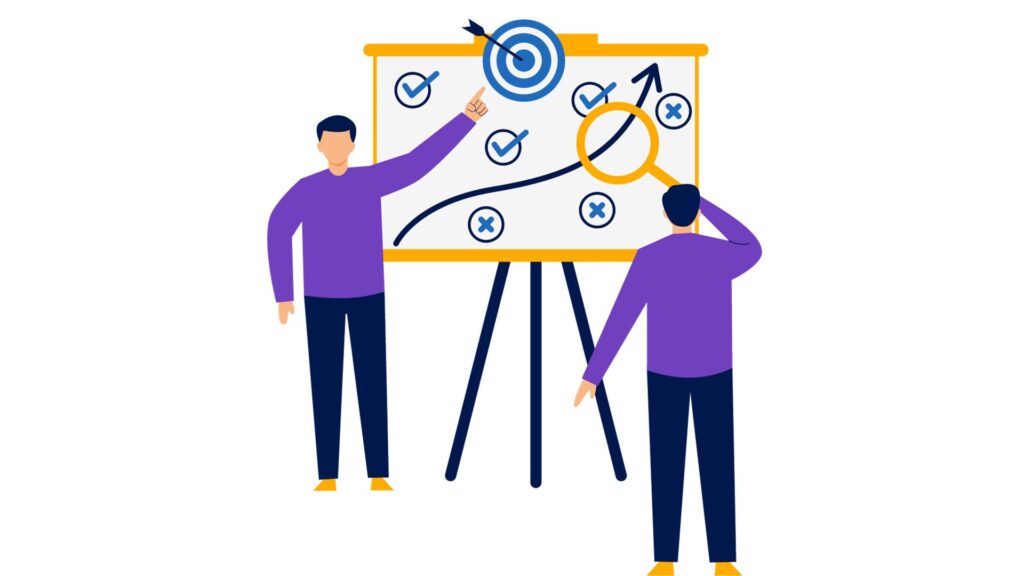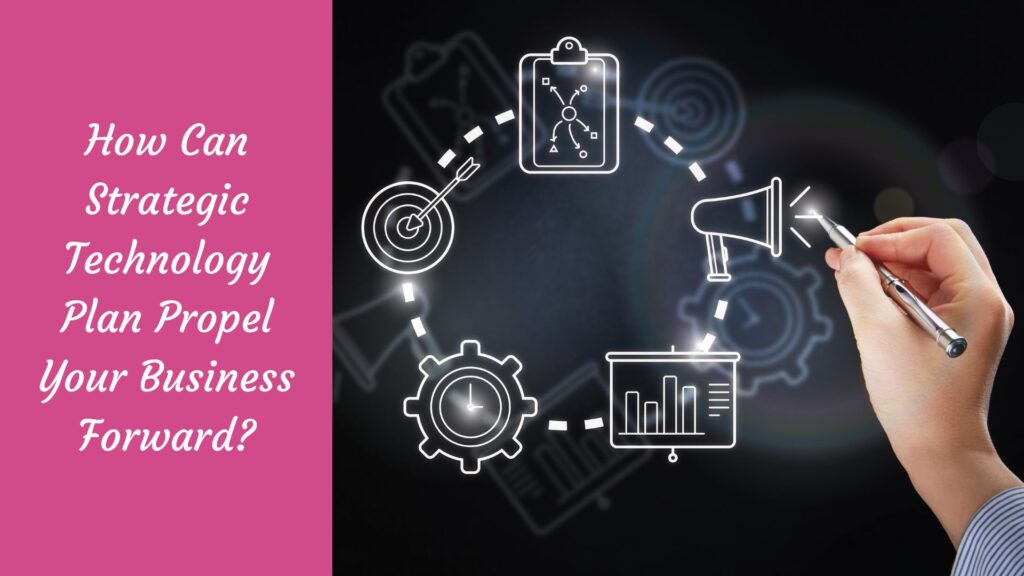In the fast-paced and ever-changing digital landscape of the 21st century, the adage ‘adapt or perish’ has never been more relevant, especially in the world of business. 💼 A well-crafted strategic technology plan can be the game-changer that propels your business to success. 🚀
But what exactly is it and why is it crucial? 🤔 This article will take you on a deep dive into the world of strategic technology planning, revealing how it can drive business growth, streamline operations, foster innovation, and ultimately give you a competitive edge in today’s cutthroat market. Get ready for a thrilling journey! 😃
What is Strategic Technology Plan?
A strategic technology plan is a roadmap that directs a business’s use of technology to align with its goals. It guides decisions on investments in hardware, software, and tech talent, including contingency plans for tech-related crises. 🗺️💡💻👥🚧

- Envisioning the Future: At its heart, a strategic technology plan is future-oriented. It envisions the role of technology in a company’s future growth and develops a roadmap to get there. For example, a retail business might plan to implement an e-commerce platform to boost online sales and outline the steps necessary to achieve this.
- Harmonizing Goals and Resources: The plan ensures that the company’s tech goals and resources are in sync. It prevents wasteful spending by ensuring that technology investments align with the company’s mission. An example could be a manufacturing company investing in automation technology to increase production efficiency.
- Risk Management: A strategic technology plan includes provisions for risk management. It addresses tech-related crises, like data breaches, and outlines plans to reduce these risks. For instance, a financial institution might plan to strengthen its cybersecurity measures to protect customer data.
Why a Strategic Technology Plan is Important
A strategic technology plan (STP) holds immense importance for businesses in today’s fast-paced digital era. Here are the reasons, backed with examples, that underline its significance: 💡📈🌐

- Driving Innovation: An STP encourages businesses to embrace innovation, helping them stay afloat in an increasingly competitive market. For instance, a healthcare organization might leverage advanced technologies like AI and machine learning to improve patient care, thus setting itself apart from competitors.
- Operational Efficiency: An STP targets the efficient use of technology resources, leading to cost savings and improved productivity. A logistics company, for example, might implement a cloud-based supply chain management system to streamline its operations.
- Customer Satisfaction: Strategic use of technology can significantly enhance customer experiences. Think of an e-commerce company that uses chatbots to provide round-the-clock customer service.
- Data-Driven Decision Making: STPs often involve the use of tools for data analysis and reporting, which can foster a culture of data-driven decision making. For example, a marketing firm might use analytics tools to track consumer behavior and tailor its strategies accordingly.
- Business Growth: Finally, a solid STP can pave the way for business expansion. A small business might implement scalable cloud solutions to support growth without the need for massive upfront investments in IT infrastructure.
15 Strategic Technology Plan You Must Follow in 2024
Here are 15 strategic technology plans your business must follow in 2024. 🔥💻📈

- Embrace Artificial Intelligence (AI): AI will continue to revolutionize businesses, from automating routine tasks to improving customer experience. For example, deploying AI-powered chatbots for customer service can significantly enhance your customers’ experience.
- Invest in Cybersecurity: With the rise of cyber threats, businesses must prioritize cybersecurity. A comprehensive cybersecurity plan can protect your business from potential data breaches.
- Leverage Cloud Technology: Cloud computing offers scalable solutions that can support business growth. For instance, using cloud-based collaboration tools can improve team efficiency.
- Adopt Internet of Things (IoT): IoT devices can drive operational efficiency. An example could be a logistics company using IoT for inventory management.
- Incorporate Big Data Analytics: Big data analytics can provide valuable insights for decision-making. For example, a marketing company can use these tools to understand customer behavior and tailor their strategies accordingly.
- Implement Remote Work Solutions: With the changing work landscape, businesses need to adopt remote work technologies. Tools such as virtual meeting platforms and project management software can enhance remote team collaboration.
- Focus on Mobile Technology: In the smartphone era, prioritizing mobile technology is vital. Creating a user-friendly app can enhance customer engagement.
- Prioritize Customer Experience (CX) Tech: Investing in CX technologies, like CRM software, can help businesses understand and serve their customers better.
- Invest in Automation: Automation can lead to significant cost savings and efficiency. An example is automating routine administrative tasks to free up employee time for more strategic tasks.
- Leverage Augmented Reality (AR) & Virtual Reality (VR): AR and VR can offer unique customer experiences. For instance, a real estate company can use VR to give virtual tours of properties.
- Adopt Blockchain Technology: Blockchain technology can offer secure and transparent transactions, especially beneficial for businesses in the financial sector.
- Invest in 5G Technology: 5G technology can significantly increase your business’s internet speed and reliability, enhancing both operational efficiency and customer experience.
- Leverage Machine Learning (ML): ML can help businesses make more accurate predictions and decisions. For example, an e-commerce business can use ML to predict customer buying patterns and personalize its offerings.
- Focus on Digital Marketing: With more consumers online, focusing on digital marketing technologies is essential. SEO and social media marketing can significantly increase your business’s visibility.
- Incorporate Green Technology: Finally, adopting green technology can help businesses reduce their environmental impact and appeal to environmentally conscious consumers. It could include investing in energy-efficient technologies or implementing paperless operations.
Best Practices for Strategic Technology Plan
Implementing a strategic technology plan can be a complex process. 😅 However, following certain best practices can help ensure the success of your plan. Here are some of the key best practices to follow: ✅

- Involve Stakeholders: Always involve key stakeholders in the planning process. This includes not only top management but also those who will be directly using the technology, such as employees, customers, and suppliers. For example, when a retail company plans to implement a new inventory management system, it should involve store managers and employees in the planning process as they will be directly using the system.
- Align with Business Goals: A strategic technology plan should not only focus on technology but also align with your broader business goals. If your business goal is to expand into a new market, your technology plan might involve implementing a customer relationship management (CRM) system to understand the new market’s customer behavior.
- Regular Evaluation and Updates: Technology and business environments can change rapidly. Therefore, it’s important to regularly evaluate and update your strategic technology plan as necessary. For instance, a publishing company that had previously focused on print media might need to update its technology plan to incorporate digital publishing tools due to changes in consumer behavior.
- Focus on Training and Support: Implementing new technology can be a challenge for employees. Make sure to provide sufficient training and support to ensure successful adoption. For instance, when a hospital implements a new electronic health record system, it should provide comprehensive training to doctors, nurses, and other staff.
- Risk Assessment and Mitigation: The implementation of every technology comes with potential risks. It’s important to identify these risks early and plan for their mitigation. For example, a financial institution implementing a new online banking system must plan for potential cybersecurity risks.
- Budgeting and Resource Allocation: Ensure that you have the necessary resources, including funds and personnel, to implement your plan. For example, a small business planning to implement a cloud-based CRM system must budget not only for the cost of the software but also for related costs like training and data migration.
- Prioritize and Phase: Instead of attempting to implement all technological changes at once, prioritize them based on their impact and feasibility. Implement changes in phases. For example, an e-commerce business planning to overhaul its website might start by improving the user interface in the first phase, followed by integrating new payment methods in the second phase.

By following these best practices, businesses can ensure that their strategic technology plan is not only successful but also aligns with their business goals and is adaptable to changing environments. ✅🚀💼🌐
Three Examples of Strategic Technology Plan

Example 1: Healthcare Sector – Hospital Adoption of Electronic Health Record (EHR) System
A hospital decides to adopt an Electronic Health Record (EHR) System as part of its strategic technology plan. After involving stakeholders, aligning with business goals, and evaluating the potential risks: 🏥✨📝
- Phase 1: They begin by selecting an EHR system that meets their needs and budget. They allocate resources for system implementation, including hiring an IT consultant and training staff.
- Phase 2: They pilot the EHR system in one department before expanding to the whole hospital. They collect feedback during this phase and make necessary system adjustments.
- Phase 3: Once system adjustments are done, the hospital rolls out the EHR system hospital-wide, providing ongoing training and support for staff. They monitor system usage and address any issues promptly.
- Phase 4: The hospital regularly evaluates and updates the EHR system to ensure it continues to meet its needs and stays aligned with evolving healthcare technology trends.
Example 2: Retail Sector – Store Chain Adoption of Inventory Management System
A retail store chain decides to implement a new inventory management system. 🛍️ The strategic technology plan for this adoption may look like this: 💡
- Phase 1: The chain involves store managers and employees in the planning process. They evaluate different systems and finally select one that aligns with their business goals and budget.
- Phase 2: They roll out the system in a few selected stores, providing comprehensive training to store managers and employees. They collect and incorporate feedback into the system during this pilot phase.
- Phase 3: Upon successful pilot testing, they implement the system across all stores, monitoring performance and addressing any arising issues promptly.
- Phase 4: The chain continually evaluates the system’s effectiveness, making necessary adjustments as it expands or adapt to changing retail trends.
Example 3: Financial Sector – Bank’s Adoption of Online Banking System
A bank decides to adopt an online banking system to enhance customer experience and streamline operations. The process may involve the following stages: 💻🏦
- Phase 1: The bank involves key stakeholders, including customers, in the planning process. They hire a professional IT team to develop a secure and user-friendly online banking system.
- Phase 2: They launch the system to a small group of customers as a pilot test, collecting user feedback and making necessary adjustments.
- Phase 3: Post successful pilot testing, they roll out the system to all customers, undertaking a digital marketing campaign to inform customers about the new system.
- Phase 4: They regularly evaluate system performance, making updates as necessary based on user feedback and evolving digital banking trends. Cybersecurity measures are continuously updated to mitigate potential risks.
Conclusion
These three examples demonstrate how businesses can strategically plan their adoption and implementation of new technology. 😃
By embracing best practices like involving stakeholders 👥, aligning with business goals 🎯, and regularly evaluating and updating the plan 🔄, businesses can ensure successful implementation and alignment with their overall strategic objectives. Businesses must have a well-defined strategic technology plan in place to stay competitive and meet the ever-evolving technological demands of their industry. 💪
By following these best practices, businesses can not only ensure the success of their strategic technology plan but also ensure it aligns with their goals and adapts to changing environments. 🌟
Prioritizing and investing in a strategic technology plan allows businesses to leverage technology as a tool for growth and success. Let technology be the driving force behind your journey to success! 🚀

